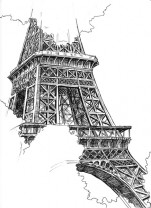Genius of Gustave Bönickhausen

This year marks the 130th anniversary of the world-famous metal tower designed by Gustav Eiffel. It became not only the most recognizable building in Paris, but also the most controversial one since the rejection of the tower during its construction was as great as its fame is huge now. French engineer Alexandre Gustave Eiffel was one of the most outstanding specialists in metal structure design of his time. During his career, he created many impressive structures, but none of them brought him such fame as the tower in Paris named after him.
This famous engineer was born on the 15th of December in 1832 in Dijon under the name of Bönickhausen. The family later adopted the name Eiffel as a reference to their native mountains. Although all family members used the name Eiffel, Gustave had not officially changed the name of Bunkhouse until 1880. When he graduated from the lycée Eiffel moved to Paris and entered the Polytechnic Institute, the faculty of chemical physics of metals. After graduating with honors, he was hired by the firm of Charles Nepveu engaged in the design and construction of bridges, railway stations and other railway transport structures.
One of the first significant works by the young engineer was the construction of a large metal railway bridge in Bordeaux with a total length of 500 m. Here for the first time he used the method of building bridge pier foundation with compressed air. Eiffel quickly realized the economic feasibility and safety of this method, which was treated with a high degree of skepticism at that time. In future construction practice will confirm the prospects and viability of this method, which has been used up to the present days.
Full content of this issue you can read here
The full version of the article can be read in our printed issue, also you can subscribe to the web-version of the magazine
 Text by Nina Konovalova, Senior Researcher, Department of the History of Architecture and Urban Planning of the Recent Times, Ph.D., Advisor to RAASN
Text by Nina Konovalova, Senior Researcher, Department of the History of Architecture and Urban Planning of the Recent Times, Ph.D., Advisor to RAASN


